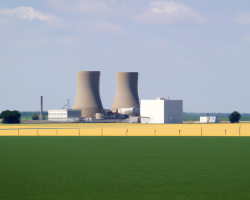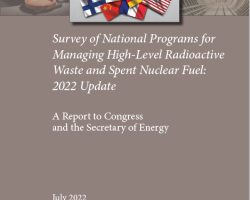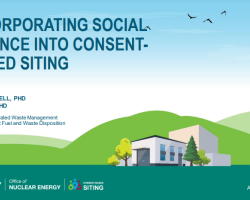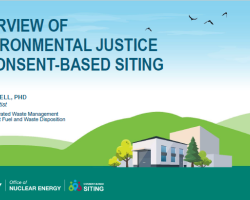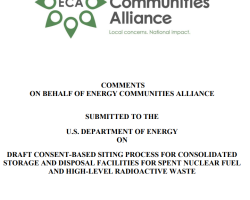Category of Content
Siting Experience Documents Only
Publication Date
Subject Matter
Country
Keywords
SCALE-4 Analysis of Pressurized Water Reactor Critical Configurations: Volume 3-Surry Unit 1 Cycle 2
SCALE-4 Analysis of Pressurized Water Reactor Critical Configurations: Volume 3-Surry Unit 1 Cycle 2
Science based responses to social myths on nuclear energy
Science based responses to social myths on nuclear energy
In order to promote a sound basis for considering the role of nuclear in climate change, this review spans the technical topics of social and political debate surrounding nuclear energy with a focus on the objective science of these issues including nuclear waste, accidents and overall risk. Novel aspects include the emergence of nuclear energy as being potentially renewable and the antithesis of Fukushima being an argument for the unacceptable risks associated with the use of nuclear energy.
Probabilistic External Criticality Evaluation
Probabilistic External Criticality Evaluation
The Likelihood of Criticality Following Disposal of SF/HLW/HEU/Pu
The Likelihood of Criticality Following Disposal of SF/HLW/HEU/Pu
Supplement to the Disposal Criticality Analysis Methodology
Supplement to the Disposal Criticality Analysis Methodology
Screening Analysis of Criticality Features, Events, and Processes for License Application
Screening Analysis of Criticality Features, Events, and Processes for License Application
Why DOE's Messages on Transportation Don't Resonate with the Public (and What DOE Can Do to Fix the Problem)
Why DOE's Messages on Transportation Don't Resonate with the Public (and What DOE Can Do to Fix the Problem)
FEDERAL COMMITMENTS REGARDING USED FUEL AND HIGH-LEVEL WASTES
FEDERAL COMMITMENTS REGARDING USED FUEL AND HIGH-LEVEL WASTES
Survey of National Programs for Managing High-Level Radioactive Waste and Spent Nuclear Fuel: 2022 Update
Survey of National Programs for Managing High-Level Radioactive Waste and Spent Nuclear Fuel: 2022 Update
In October 2009, the U.S. Nuclear Waste Technical Review Board (Board or NWTRB) published Survey of National Programs for Managing High-Level Radioactive Waste and Spent Nuclear Fuel. For each of the 13 national programs studied, the report catalogued 15 institutional arrangements that had been set in place and 15 technical approaches that had been taken to design repository systems for the long-term management of high-activity radioactive waste.
Incorporating International Siting Best Practices and Lessons Learned
Incorporating International Siting Best Practices and Lessons Learned
Presentation at the U. S. Nuclear Waste Technical Review Board (NWTRB) meeting held in Idaho Falls, Idaho, on August 29 and 30, 2023.
Incorporating Social Science into Consent-Based Siting
Incorporating Social Science into Consent-Based Siting
Presented at the U. S. Nuclear Waste Technical Review Board (NWTRB) meeting held in Idaho Falls, Idaho, on August 29 and 30, 2023.
UNF-STANDARDS presentation to EPRI extended storage collaboration project
UNF-STANDARDS presentation to EPRI extended storage collaboration project
Understanding the changing nuclear and mechanical characteristics of used nuclear fuel (UNF) over time and how these changing characteristics affect storage, transportation, and disposal options can require many tools and types of data. To streamline analysis capabilities for the waste management system, a comprehensive, integrated data and analysis tool has been assembled—UNF-Storage, Transportation & Disposal Analysis Resource and Data System (UNF-ST&DARDS).
Presentation made at IAEA on A Unified Spent Nuclear Fuel (SNF) Database and Analysis System
Presentation made at IAEA on A Unified Spent Nuclear Fuel (SNF) Database and Analysis System
Presentation made at International Conference on The Management of Spent Nuclear Fuel from Nuclear Power Reactors, An Integrated approach to the Back-End of the Fuel Cycle (IAEA-CN-226). The purpose of the conference was to highlight the importance of an integrated long-term approach to the management of spent fuel from nuclear power reactors.
Sister Rod Examinations at ORNL for the HBU Spent Fuel Data Project
Sister Rod Examinations at ORNL for the HBU Spent Fuel Data Project
Presentation made at the Electric Power Research Institute (EPRI) Extended Storage Collaboration Project (ESCP) meeting November 2016 discussing the status of nondestructive examinations being performed on high burnup (HBU) sent nuclear fuel (SNF) rods at Oak Ridge National Laboratory and proposed destructive examinations that will be performed over the next several years.
Overview of Environmental Justice in Consent-Based Siting
Overview of Environmental Justice in Consent-Based Siting
Presentation at the U. S. Nuclear Waste Technical Review Board (NWTRB) meeting held in Idaho Falls, Idaho, on August 29 and 30, 2023.
Hosting a Nuclear Facility: Mayors Discuss Role of Community Engagement
Hosting a Nuclear Facility: Mayors Discuss Role of Community Engagement
Engaging local stakeholders through transparent and open dialogue is pivotal for the success of nuclear projects. Engagement requires time, trust-building and adaptability as expectations evolve. In many places, communities that initially expressed scepticism or opposition have become advocates because of this engagement and better understanding of what it means to host a nuclear facility.
Comments on the Draft Consent-Based Siting Report and ECA Recommendations
Comments on the Draft Consent-Based Siting Report and ECA Recommendations
Comments on behalf of Energy Communities Alliance submitted to the U.S. Department of Energy on Draft Consent-Based Siting Process for Consolidated Storage and Disposal Facilities for Spent Nuclear Fuel and High-Level Radioactive Waste.
A Community Handbook on Nuclear Energy
A Community Handbook on Nuclear Energy
This handbook was prepared by Energy Communities Alliance (ECA) with funding from the U.S. Department of Energy (DOE), Office of Nuclear Energy, under Cooperative Agreement DE-NE0000006. It does not represent the views of the Department of Energy, and no official endorsement should be inferred. This handbook is an update to the version originally released in March 2012. The authors are Kara Colton, Allison Doman and Seth Kirshenberg of ECA.
slides - Strategy for the Management and Disposal of Used Nuclear Fuel and High-Level Radioactive Waste
slides - Strategy for the Management and Disposal of Used Nuclear Fuel and High-Level Radioactive Waste
Presented at the NEI Used Fuel Management Conference, St. Petersburg, FL, May 7-9, 2013
CSNF Loading Curve Sensitivity Analysis
CSNF Loading Curve Sensitivity Analysis
The purpose of this scientific analysis report, CSNF Loading Curve Sensitivity Analysis, is to establish the required minimum burnup as a function of initial enrichment for both pressurized water reactor (PWR) and boiling water reactor (BWR) commercial spent nuclear fuel (CSNF) that would allow permanent disposal of these waste forms in the geologic repository at Yucca Mountain. The relationship between the required minimum burnup and fuel assembly initial enrichment forms a loading curve.
DOE SNF Phase I and II Summary Report
DOE SNF Phase I and II Summary Report
There are more than 250 forms of U.S. Department of Energy (DOE)owned spent nuclear fuel (SNF). Due to the variety of the spent nuclear fuel, the National Spent Nuclear Fuel Program (NSNFP) has designated nine representative fuel groups for disposal criticality analyses based on fuel matrix, primary fissile isotope, and enrichment. For each fuel group, a fuel type that represents the characteristics of all fuels in that group has been selected for detailed analysis.
Initial Radionuclide Inventories
Initial Radionuclide Inventories
The purpose of this analysis is to provide an initial radionuclide inventory (in grams per waste package) and associated uncertainty distributions for use in the Total System Performance Assessment for the License Application (TSPA-LA) in support of the license application for the repository at Yucca Mountain, Nevada. This document is intended for use in postclosure analysis only.
Spent Fuel Project Office, Interim Staff Guidance - 8, Revision 1, Burnup Credit in the Criticality Safety Analyses of PWR Spent Fuel in Transport and Storage Casks
Spent Fuel Project Office, Interim Staff Guidance - 8, Revision 1, Burnup Credit in the Criticality Safety Analyses of PWR Spent Fuel in Transport and Storage Casks
Spent Fuel Project Office, Interim Staff Guidance - 8, Revision 1
OECD/NEA Burnup Credit Criticality Benchmarks Phase IIIB: Burnup Calculations of BWR Fuel Assemblies for Storage and Transport
OECD/NEA Burnup Credit Criticality Benchmarks Phase IIIB: Burnup Calculations of BWR Fuel Assemblies for Storage and Transport
The report describes the final results of the Phase IIIB Benchmark conducted by the
Expert Group on Burnup Credit Criticality Safety under the auspices of the Nuclear Energy
Agency (NEA) of the Organization for Economic Cooperation and Development (OECD).
The Benchmark was intended to compare the predictability of current computer code and
data library combinations for the atomic number densities of an irradiated BWR fuel
assembly model. The fuel assembly was irradiated under specific power of 25.6 MW/tHM
